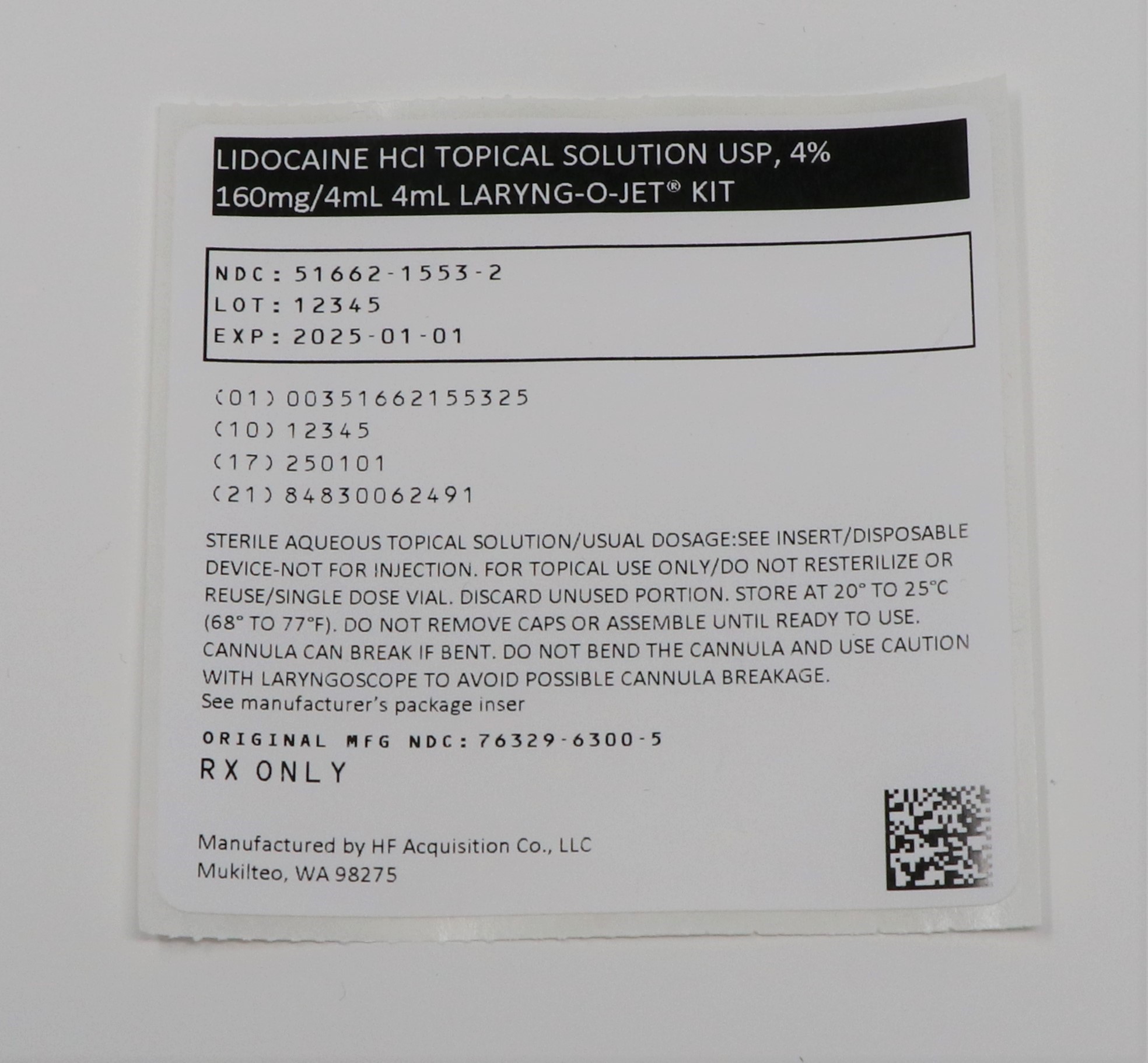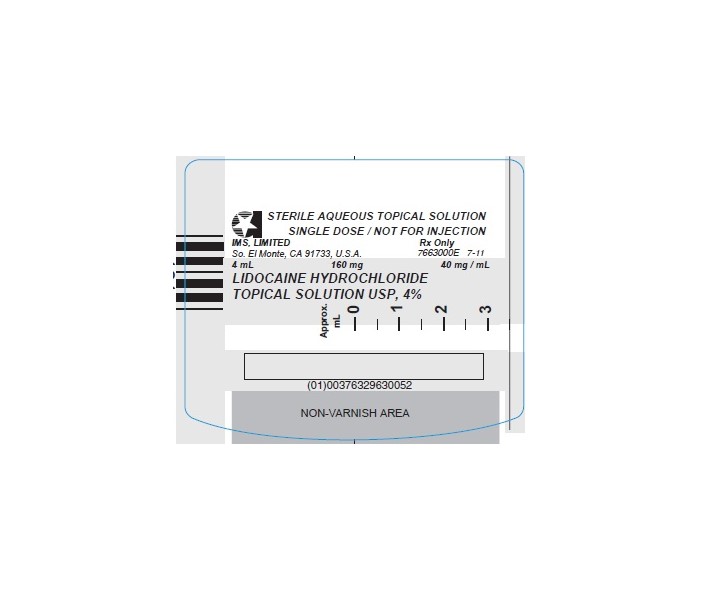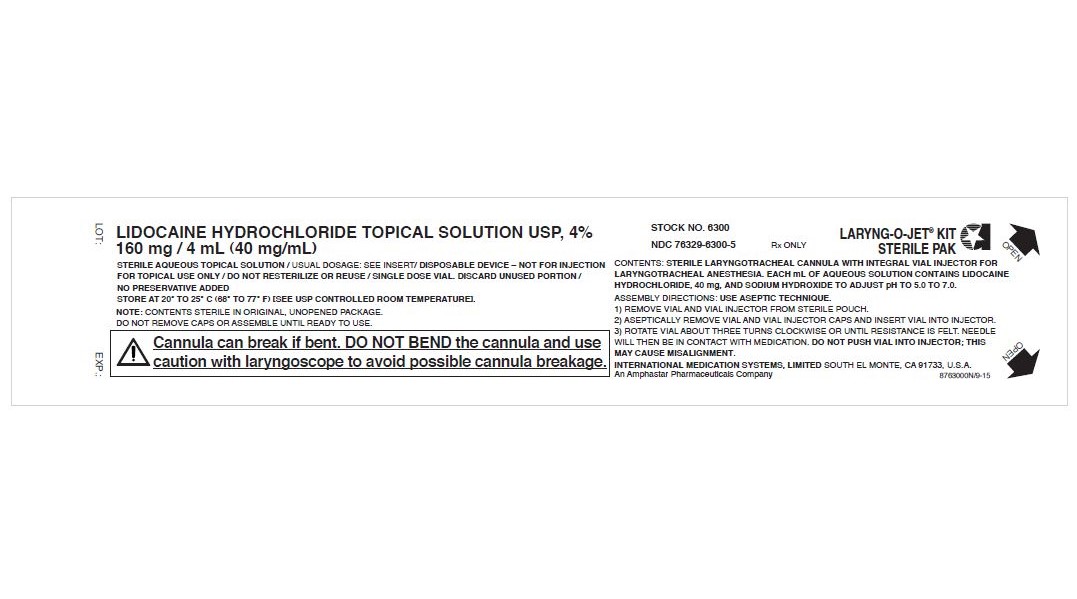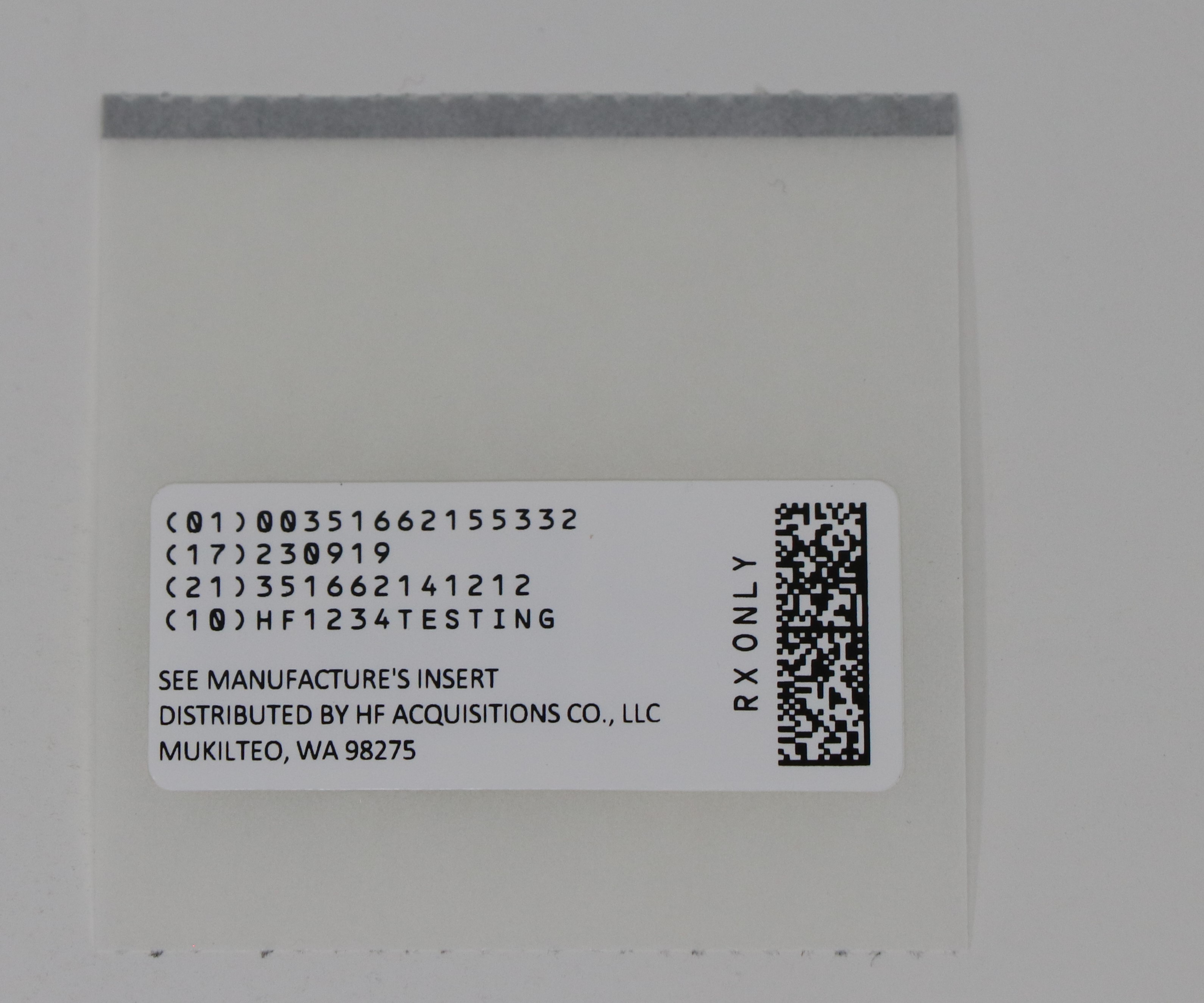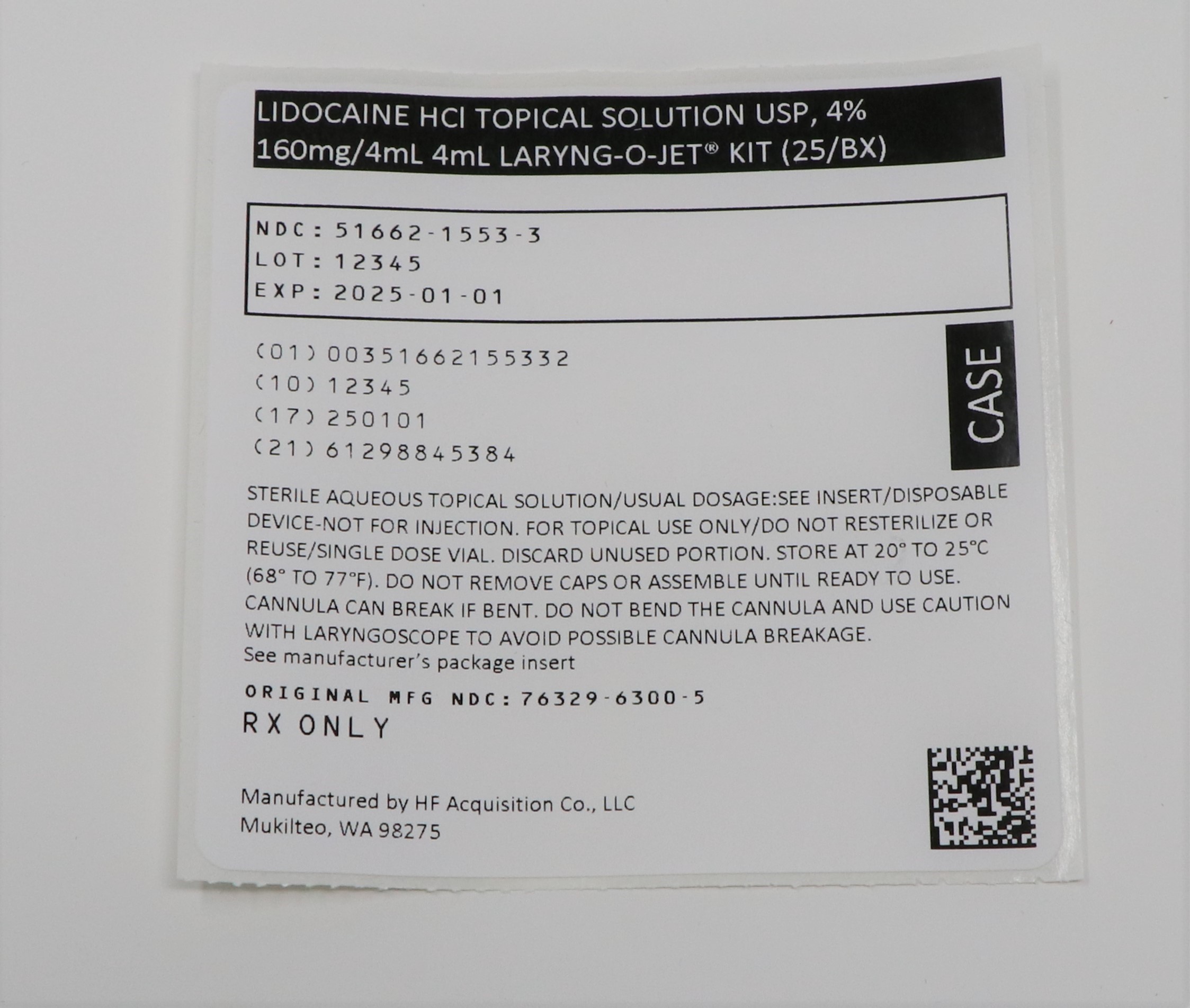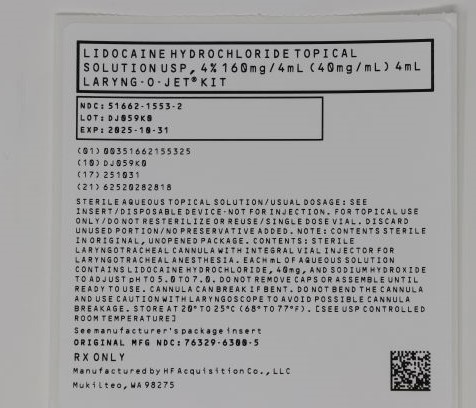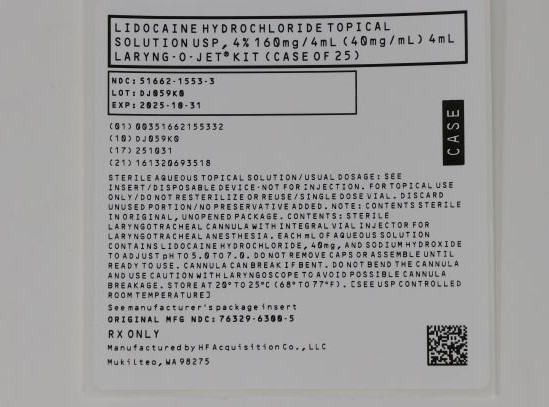LIDOCAINE HCl by HF Acquisition Co LLC, DBA HealthFirst LIDOCAINE HCL solution
LIDOCAINE HCl by
Drug Labeling and Warnings
LIDOCAINE HCl by is a Prescription medication manufactured, distributed, or labeled by HF Acquisition Co LLC, DBA HealthFirst. Drug facts, warnings, and ingredients follow.
Drug Details [pdf]
-
DESCRIPTION
Lidocaine HCI Topical Solution USP, 4% is a sterile, aqueous solution containing a local anesthetic agent and is administered topically.
Lidocaine hydrochloride is designated chemically as acetamide, 2-(diethylamino)-N-(2, 6-dimethylphenyl)-monohydrochloride, with the following structural formula:
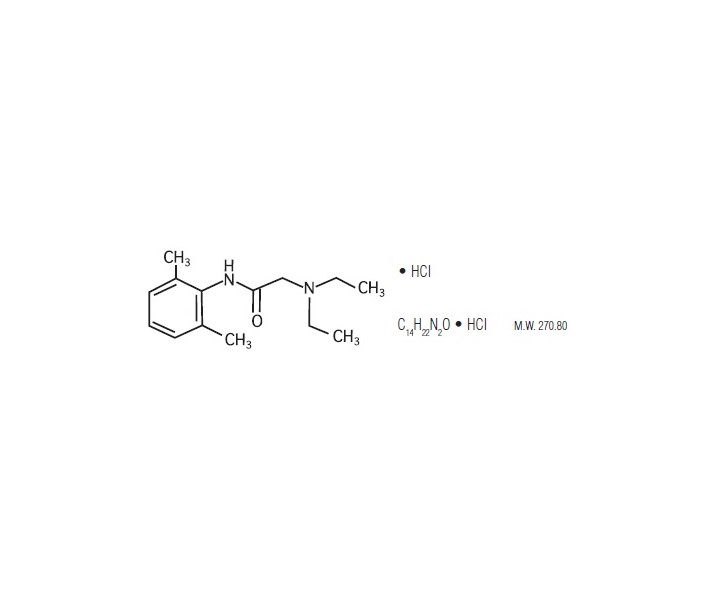 Composition of Lidocaine HCI 4% Topical Solution: Each mL of aqueous solution contains lidocaine HCI, 40 mg, and sodium hydroxide and/or hydrochloric acid to adjust pH to 5.0 to 7.0. No preservative is added since all or part of the contents of the syringe unit is administered as a single dose and the unit should not be re-used.
Composition of Lidocaine HCI 4% Topical Solution: Each mL of aqueous solution contains lidocaine HCI, 40 mg, and sodium hydroxide and/or hydrochloric acid to adjust pH to 5.0 to 7.0. No preservative is added since all or part of the contents of the syringe unit is administered as a single dose and the unit should not be re-used.
-
CLINICAL PHARMACOLOGY
Mechanism of Action: Lidocaine stabilizes the neuronal membrane by inhibiting the ionic fluxes required for the initiation and conduction of impulses, thereby effecting local anesthetic action. The onset of action is rapid.
Hemodynamics: Excessive blood levels may cause changes in cardiac output, total peripheral resistance, and mean arterial pressure. These changes may be attributable to a direct depressant effect of the local anesthetic agent on various components of the cardiovascular system. The net effect is normally a modest hypotension when the recommended dosages are not exceeded.
Pharmacokinetics and Metabolism: Lidocaine may be absorbed following topical administration to mucous membranes, its rate and extent of absorption depending upon concentration and total dose administered, the specific site of application, and duration of exposure. In general, the rate of absorption of local anesthetic agents following topical application occurs most rapidly after intratracheal administration. Lidocaine is also well-absorbed from the gastrointestinal tract, but little intact drug appears in the circulation because of biotransformation in the liver.
Lidocaine is metabolized rapidly by the liver, and metabolites and unchanged drug are excreted by the kidneys. Biotransformation includes oxidative N-dealkylation, ring hydroxylation, cleavage of the amide linkage, and conjugation. N-dealkylation,a major pathway of biotransformation, yields the metabolites monoethylglycinexylidide and glycinexylidide. The pharmacological/toxicological actions of these metabolites are similar to, but less potent than those of lidocaine. Approximately 90% of lidocaine administered is excreted in the form of various metabolites, and less than 10% is excreted unchanged. The primary metabolite in urine is a conjugate of 4-hydroxy-2,6-dimethylaniline.
Studies have shown that peak blood levels of lidocaine may occur as early as 5 and as late as 30 minutes after endotracheal administration of a 4% lidocaine HCI solution.
The plasma binding of lidocaine is dependent on drug concentration, and the fraction bound decreases with increasing concentration. At concentrations of 1 to 4 μg of free base per mL, 60 to 80 percent of lidocaine is protein bound. Binding is also dependent on the plasma concentration of the alpha-1-acid glycoprotein.
Lidocaine crosses the blood-brain and placental barriers, presumably by passive diffusion.
Studies of lidocaine metabolism following intravenous bolus injections have shown that the elimination half-life of this agent is typically 1.5 to 2 hours. Because of the rapid rate at which lidocaine is metabolized, any condition that affects liver function may alter lidocaine kinetics. The half-life may be prolonged two-fold or more in patients with liver dysfunction. Renal dysfunction does not affect lidocaine kinetics but may increase the accumulation of metabolites.
Factors such as acidosis and the use of CNS stimulants and depressants affect the CNS levels of lidocaine required to produce overt systemic effects. Objective adverse manifestations become increasingly apparent with increasing venous plasmalevels above 6 μg free base per mL. In the rhesus monkey arterial blood levels of 18-21μg/mL have been shown to be threshold for convulsive activity.
- INDICATIONS & USAGE
- CONTRAINDICATIONS
-
WARNINGS
LIDOCAINE HCI TOPICAL SOLUTION SHOULD BE EMPLOYED ONLY BY CLINICIANS WHO ARE WELL VERSED IN DIAGNOSIS AND MANAGEMENT OF DOSE-RELATED TOXICITY AND OTHER ACUTE EMERGENCIES THAT MIGHT ARISE AND THEN ONLY AFTER ENSURING THE IMMEDIATE AVAILABILITY OF OXYGEN, OTHER RESUSCITATIVE DRUGS, CARDIOPULMONARY EQUIPMENT, AND THE PERSONNEL NEEDED FOR PROPER MANAGEMENT OF TOXIC REACTIONS AND RELATED EMERGENCIES. (See also “ ADVERSE REACTIONS” and “ PRECAUTIONS.”) DELAY IN PROPER MANAGEMENT OF DOSE-RELATED TOXICITY, UNDERVENTILATION FROM ANY CAUSE AND/OR ALTERED SENSITIVITY MAY LEAD TO THE DEVELOPMENT OF ACIDOSIS, CARDIAC ARREST AND, POSSIBLY, DEATH.
Lidocaine HCI Topical Solution should be used with extreme caution if there is sepsis or severely traumatized mucosa in the area of application, since under such conditions there is the potential for rapid systemic absorption.
-
PRECAUTIONS
General: The pre-attached curved cannula is flexible but not unbreakable. Do not bend or manipulate prior to or during use, or use in conjunction with any device other than a laryngoscope. Cannula tip breakage during intratracheal anesthesia requires the tip be manually removed, prolonging anesthesia and adding additional procedural risks.
The safety and effectiveness of lidocaine depend on proper dosage, correct technique, adequate precautions, and readiness for emergencies. Resuscitative equipment, oxygen and other resuscitative drugs should be available for immediate use. (See “ WARNINGS” and “ ADVERSE REACTIONS”.) The lowest dosage that results in effective anesthesia should be used to avoid high plasma levels and serious adverse effects. Repeated doses of lidocaine may cause significant increases in blood levels with each repeated dose because of slow accumulation of the drug or its metabolites. Tolerance to elevated blood levels varies with the status of the patient. Debilitated, elderly patients, acutely ill patients, and children should be given reduced doses commensurate with their age and physical status. Lidocaine should also be used with caution in patients with severe shock or heart block.
Careful and constant monitoring of cardiovascular and respiratory (adequacy of ventilation) vital signs and the patient’s state of consciousness should be accomplished after each local anesthetic injection. It should be kept in mind at such times that restlessness, anxiety, tinnitus, dizziness, blurred vision, tremors, depression or drowsiness may be early warning signs of central nervous system toxicity.
Since amide-type local anesthetics are metabolized by the liver, Lidocaine HCI Topical Solution should be used with caution in patients with hepatic disease. Patients with severe hepatic disease, because of their inability to metabolize local anesthetics normally, are at a greater risk of developing toxic plasma concentrations. Lidocaine HCI Topical Solution should also be used with caution in patients with impaired cardiovascular function since they may be less able to compensate for functional changes associated with the prolongation of A-V conduction produced by these drugs.
Many drugs used during the conduct of anesthesia are considered potential triggering agents for familial malignant hyperthermia. Since it is not known whether amide-type local anesthetics may trigger this reaction and since the need for supplemental general anesthesia cannot be predicted in advance, it is suggested that a standard protocol for management should be available. Early unexplained signs of tachycardia, tachypnea, labile blood pressure and metabolic acidosis may precede temperature elevation. Successful outcome is dependent on early diagnosis, prompt discontinuance of the suspect triggering agent(s) and institution of treatment, including oxygen therapy, indicated supportive measures and dantrolene (consult dantrolene sodium intravenous package insert before using).
Lidocaine should be used with caution in persons with known drug sensitivities. Patients allergic to para-amino-benzoic acid derivatives (procaine, tetracaine, benzocaine, etc.) have not shown cross sensitivity to lidocaine.
Information for Patients: When topical anesthetics are used in the mouth, the patient should be aware that the production of topical anesthesia may impair swallowing and thus enhance the danger of aspiration. For this reason, food should not be ingestedfor 60 minutes following use of local anesthetic preparations in the mouth or throat area. This is particularly important in children because of their frequency of eating.
Numbness of the tongue or buccal mucosa may enhance the danger of unintentional biting trauma. Food and chewing gum should not be used while the mouth or throat area is anesthetized.
Carcinogenesis, Mutagenesis, Impairment of Fertility: Studies of lidocaine in animals to evaluate the carcinogenic and mutagenic potential or the effect on fertility have not been conducted.
Use in Pregnancy: Teratogenic Effects: Pregnancy Category B
Reproduction studies have been performed in rats at doses up to 6.6 times the human dose and have revealed no evidence of harm to the fetus caused by lidocaine. There are, however, no adequate and well-controlled studies in pregnant women. Animal reproduction studies are not always predictive of human response. General consideration should be given to this fact before administering lidocaine to women of childbearing potential, especially during early pregnancy when maximum organogenesis takes place.
Labor and delivery: Lidocaine is not contraindicated in labor and delivery. Should Lidocaine HCI Topical Solution be used concomitantly with other products containing lidocaine, the total dose contributed by all formulations must be kept in mind.
Nursing mothers: It is not known whether this drug is excreted in human milk. Because many drugs are excreted in human milk, caution should be exercised when lidocaine is administered to a nursing woman.
Pediatric use: Dosages in children should be reduced, commensurate with age and body weight. See “ DOSAGE AND ADMINISTRATION.”
-
ADVERSE REACTIONS
Adverse experiences following the administration of lidocaine are similar in nature to those observed with other amide local anesthetic agents. These adverse experiences are, in general, dose-related and may result from high plasma levels caused by excessive dosage or rapid absorption, or may result from a hypersensitivity, idiosyncrasy or diminished tolerance on the part of the patient. Serious adverse experiences are generally systemic in nature.
The following types are those most commonly reported:
Central Nervous System: CNS manifestations are excitatory and/or depressant and may be characterized by lightheadedness, nervousness, apprehension, euphoria, confusion, dizziness, drowsiness, tinnitus, blurred or double vision, vomiting, sensations of heat, cold or numbness, twitching, tremors, convulsions, unconsciousness, respiratory depression and arrest. The excitatory manifestations may be very brief or may not occur at all, in which case the first manifestation of toxicity may be drowsiness merging into unconsciousness and respiratory arrest.
Drowsiness following the administration of lidocaine is usually an early sign of a high blood level of the drug and may occur as a consequence of rapid absorption.
Cardiovascular System: Cardiovascular manifestations are usually depressant and are characterized by bradycardia, hypotension, and cardiovascular collapse, which may lead to cardiac arrest.
Allergic: Allergic reactions are characterized by cutaneous lesions, urticaria, edema or anaphylactoid reactions. Allergic reactions as a result of sensitivity to lidocaine are extremely rare and, if they occur, should be managed by conventional means. The detection of sensitivity by skin testing is of doubtful value.
Neurologic: The incidences of adverse reactions associated with the use of local anesthetics may be related to the total dose of local anesthetic administered and are also dependent upon the particular drug used, the route of administration and the physicalstatus of the patient.
-
OVERDOSAGE
Acute emergencies from local anesthetics are generally related to high plasma levels encountered during therapeutic use of local anesthetics. See “ ADVERSE REACTIONS”, “ WARNINGS” and “ PRECAUTIONS.”
The intravenous LD50 of lidocaine HCl in female mice is 26 (21-31) mg/kg and the subcutaneous LD50 is 264 (203-304) mg/kg.
Management of Local Anesthetic Emergencies: The first consideration is prevention, best accomplished by careful and constant monitoring of cardiovascular and respiratory vital signs and the patient’s state of consciousness after each local anestheticadministration. At the first sign of change, oxygen should be administered.The first step in the management of convulsions consists of immediate attention to the maintenance of a patent airway and assisted or controlled ventilation with oxygen and a delivery system capable of permitting immediate positive airway pressure by mask. Immediately after the institution of these ventilatory measures, the adequacy of the circulation should be evaluated, keeping in mind that drugs used to treat convulsions sometimes depress the circulation when administered. Should convulsions persist despite adequate respiratory support, and if the status of the circulation permits, small increments of an ultra-short acting barbiturate (such as thiopental or thiamylal) or a benzodiazepine (such as diazepam) may be administered intravenously. The clinician should be familiar, prior to use of local anesthetics, with these anticonvulsant drugs. Supportive treatment of circulatorydepression may require administration of intravenous fluids and, when appropriate, a vasopressor as directed by the clinical situation (e.g., ephedrine).
If not treated immediately, both convulsions and cardiovascular depression can result in hypoxia, acidosis, bradycardia, arrhythmias and cardiac arrest. If cardiac arrest should occur, standard cardiopulmonary resuscitative measures should be instituted.
Endotracheal intubation, employing drugs and techniques familiar to the clinician, may be indicated, after initial administration of oxygen by mask, if difficulty is encountered in the maintenance of a patent airway or if prolonged ventilatory support (assisted or controlled) is indicated.
Dialysis is of negligible value in the treatment of acute overdosage with lidocaine.
-
DOSAGE & ADMINISTRATION
When Lidocaine HCI Topical Solution is used concomitantly with other products containing lidocaine, the total dose contributed by all formulations must be kept in mind.
The dosage varies and depends upon the area to be anesthetized, vascularity of the tissues, individual tolerance and the technique of anesthesia. The lowest dosage needed to provide effective anesthesia should be administered. Dosages should be reduced for children and for elderly and debilitated patients.
Although the incidence of adverse effects with Lidocaine HCI Topical Solution is quite low, caution should be exercised, particularly when employing large volumes and concentrations of Lidocaine HCI Topical Solution since the incidence of adverse effects is directly proportional to the total dose of local anesthetic agent administered. For specific techniques and procedures refer to standard textbooks. The dosages below are for normal, healthy adults.
Topical Application: For laryngoscopy, bronchoscopy and endotracheal intubation, the pharynx may be sprayed with 1-5 mL (40-200 mg lidocaine HCI), i.e., 0.6-3 mg/kg or 0.3-1.5 mg/lb body weight. For local anesthesia by the transtracheal route, it may be occasionally necessary to spray the pharynx by oropharyngeal spray to achieve complete analgesia.
Maximum Recommended Dosages:
Normal Healthy Adults:The maximum recommended dose of Lidocaine HCI Topical Solution, should be such that the dose of lidocaine HCI is kept below 300 mg and in any case should not exceed 4.5 mg/kg (2 mg/lb) body weight.
Children: It is difficult to recommend a maximum dose of any drug for children since this varies as a function of age and weight. For children of less than ten years who have a normal lean body mass and normal body development, the maximum dose may be determined by the application of one of the standard pediatric drug formulas (e.g. Clark’s rule). For example, in a child of five years weighing 50 Ibs., the dose of lidocaine HCI should not exceed 75-100 mg when calculated according to Clark’s rule. The amount of Lidocaine HCI Topical Solution administered should be such that the dose of lidocaine is kept below 300 mg and in any case should not exceed 4.5 mg/kg (2.0 mg/lb) of body weight.
Directions for Use
DESCRIPTION
The LARYNG-O-JET® is a disposable kit for producing rapid, effective topical anesthesia of the interior of the larynx and trachea. The kit contains (1) a sterile, anatomically-curved plastic cannula with attached vial injector, and (2) a single-dose vial prefilled with 4 mL of a 4% sterile aqueous solution of lidocaine hydrochloride. Medication, cannula and fluid pathway are sterile in original, unopened package. The kit is designed for one-time use only. After use, it may be discarded without disassembly.
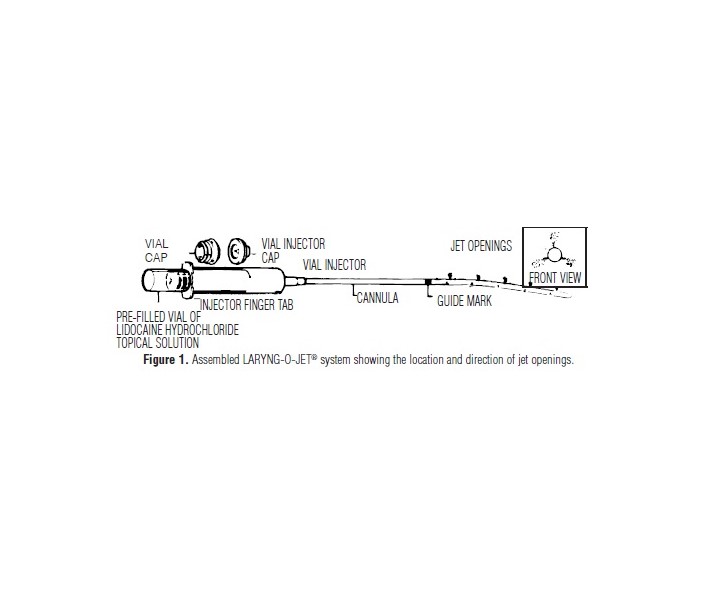
USE
The LARYNG-O-JET® Kit is used to instill a jet spray of lidocaine hydrochloride topical solution into the interior of the larynx and trachea for local anesthesia in the unconscious patient just prior to endotracheal intubation. This form of application also is effective as a final stage of topical anesthesia in the conscious patient (after initial use of an atomizer spray or other appropriate technique for applying topical anesthetic to the pharynx and epiglottis) prior to laryngeal or tracheobronchial endoscopic procedures.
DIRECTIONS
Use Aseptic Technique
DO NOT ASSEMBLE UNTIL READY TO USE
IMPORTANT:
Cannula can break if bent. DO NOT BEND the cannula and use caution with laryngoscope to avoid possible cannula breakage.
Cases of cannula tip breakage during or immediately prior to use have been reported. Cannula tip breakage is thought to be related to user
manipulation prior to or during use, or with concomitant use with other intubation devices. (see PRECAUTIONS).
Use of the LARYNG-O-JET® Kit requires strict observance of precautions appropriate to use of topical anesthesia in the respiratory tract.For Use Prior to Intubation During Anesthesia Induction (Unconscious Patient):
1. Open kit following peel pouch directions.
2. Remove vial and vial injector from bag.
3. Aseptically remove vial and vial injector caps and insert vial into injector.
4. Rotate vial about three turns clockwise or until resistance is felt. DO NOT PUSH VIAL INTO INJECTOR; THIS MAY CAUSE MISALIGNMENT. Needle will then be in contact with medication (Fig. 1). Assembled unit should remain sterile in field until laryngoscopy has been completed.
*The pre-attached curved cannula is flexible but not unbreakable. Cannula can break if bent. DO NOT BEND OR MANIPULATE PRIOR TO USE to avoid possible cannula breakage.
5. Before instillation, manually ventilate the patient with 5 or 6 deep breaths of 100% oxygen (denitrogenate with at least 5 minutes of high flow semi-closed 100% oxygen administration in patients with low cardio-respiratory, circulatory, or hematologic reserve).
6. Predetermine dose (volume) of anesthetic to be instilled and expel excess solution.
7. After hypnosis and muscle relaxation have developed fully and oxygenation has been accomplished as above, perform laryngoscopy in conventional manner. See Fig. 2.
Figure 2. Laryngoscopist's view showing cannula in place in adult larynx and trachea, with black guide mark just proximal to cords.
8. Hold injector in manner of holding a pen, and insert tip of cannula between vocal cords and into trachea to the proper depth for instillation of local anesthetic. The black guide mark is positioned just proximal to vocal cords. At this depth, interior of larynx will be bathed with anesthetic solution from upper jet orifices and entire tracheal wall by lower jet openings. (NOTE: Black mark on cannula shaft indicates approximate depth for insertion in most normal patients without touching carina with distal tip.) Caution and gentleness during insertion should be observed and the cannula advanced a proportionately shorter distance in those persons suspected of having a high tracheal bifurcation or tracheobronchial anomaly. USE CAUTION WITH LARYNGOSCOPE TO A VOID POSSIBLE CANNULA BREAKAGE.
9. With cannula at proper depth, depress syringe plunger rapidly to produce a jet-like instillation for bathing walls of larynx and trachea. NOTE: Depression of syringe plunger too slowly may fail to eject solution with sufficient velocity to reach all parts of the larynx and trachea.
10. Withdraw unit and discard.
11. Proceed with intubation.For Use in Endoscopic Procedures to Supplement Initial Atomizer Spray of Local Anesthetic (Conscious Patient):
1. Predetermine dose and assemble unit as in steps 1, 2, 3, 4 and 6 (above).
2. Before instillation apply an initial local anesthetic to the pharynx and epiglottis using an atomizer spray or other appropriate technique.
3. Follow steps 8, 9 and 10 (above) for instillation.
4. Proceed with desired laryngeal or tracheobronchial endoscopy. -
HOW SUPPLIED
In unit use packages containing one sterile disposable laryngotracheal cannula with attached vial injector, and one disposable single dose vial prefilled with sterile, aqueous solution of lidocaine hydrochloride.
NDC: 51662-1553-2 LIDOCAINE HCl TOPICAL SOLUTION USP, 4% 160mg/4mL 4mL LARYNG-O-JET® KIT, 1 per Pouch
NDC: 51662-1553-3 LIDOCAINE HCl TOPICAL SOLUTION USP, 4% 160mg/4mL 4mL LARYNG-O-JET® KIT, 1 per Pouch, 25 per Case
HF Acquisition Co LLC, DBA HealthFirst
11629 49th Pl W.Mukilteo, WA 98275
Store at 20° to 25°C (68° to 77°F)[see USP Controlled Room Tempertaure].
- PRINCIPAL DISPLAY PANEL - 51662-1553-2, POUCH AND VIAL LABELING
- PRINCIPAL DISPLAY PANEL - 51662-1553-3, CASE LABELING
- PRINCIPAL DISPLAY PANEL - 51662-1553-2, POUCH Updated September 2022
- PRINCIPAL DISPLAY PANEL - 51662-1553-3, Case Labeling Updated September 2022
-
INGREDIENTS AND APPEARANCE
LIDOCAINE HCL
lidocaine hcl solutionProduct Information Product Type HUMAN PRESCRIPTION DRUG Item Code (Source) NDC: 51662-1553(NDC:76329-6300) Route of Administration TOPICAL Active Ingredient/Active Moiety Ingredient Name Basis of Strength Strength LIDOCAINE HYDROCHLORIDE (UNII: V13007Z41A) (LIDOCAINE - UNII:98PI200987) LIDOCAINE 40 mg in 1 mL Inactive Ingredients Ingredient Name Strength SODIUM HYDROXIDE (UNII: 55X04QC32I) HYDROCHLORIC ACID (UNII: QTT17582CB) Packaging # Item Code Package Description Marketing Start Date Marketing End Date 1 NDC: 51662-1553-3 25 in 1 CASE 06/14/2021 1 NDC: 51662-1553-2 1 in 1 POUCH 1 4 mL in 1 VIAL; Type 0: Not a Combination Product Marketing Information Marketing Category Application Number or Monograph Citation Marketing Start Date Marketing End Date ANDA ANDA086364 06/14/2021 Labeler - HF Acquisition Co LLC, DBA HealthFirst (045657305) Registrant - HF Acquisition Co LLC, DBA HealthFirst (045657305) Establishment Name Address ID/FEI Business Operations HF Acquisition Co LLC, DBA HealthFirst 045657305 relabel(51662-1553)
© 2025 FDA.report
This site is not affiliated with or endorsed by the FDA.
